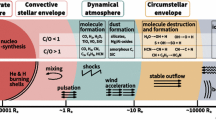Abstract
We analyze spectra of V838 Mon and V4332 Sgr taken in 2004–2005 using the 6 m telescope of the Special Astrophysical Observatory with the UAGS and SCORPIO spectrographs; the spectra have a resolution of 4.6 Å and a high signal-to-noise ratio. We confirm that V838 Mon is a spectral binary containing a B3V star and cool oxygen-rich star. We identify AlO, TiO, VO, ScO, BaO, ZrO, and YO molecular bands in the cool star’s spectrum. The TiO absorption band at λ4423 Å overlaps the continuum of the hot B3V star, testifying that the hot star and its cool companion form a wide physical pair. Further evidence for the components’ interaction is the presence of forbidden [Fell] lines that become stronger in the blue. We detected significant spectral variability of the cool star during 10 months in 2004. The spectrum of V4332 Sgr in 2005 (11 years after the outburst) contains emission lines of neutral metal atoms and of metal oxides against a photospheric continuum with a blackbody temperature of 2700 K. We identify the AlI, CaI, CrI, MnI, and SrI resonance lines and molecular emission lines of AlO, TiO, and VO, along with numerous emission lines of CrI in the spectrum. The MgI λ4571 Å intercombination line is present. The emission lines are formed in a large volume of cool low-density gas. We conclude based on spectroscopy combined with archive photographs and modern CCD photometry that both peculiar red novae were binaries prior to their outbursts, and contained blue hot components that exploded. The secondary of V838 Mon is a hot B3V star, and that of V4332 Sgr is a cool M7 star.
Similar content being viewed by others
References
R. M. Rich, J. Mould, A. Picard, et al., Astrophys. J. 341, L51 (1989).
U. Munari, A. Henden, R. M. L. Corradi, and T. Zwitter, in Classical Novae Explosions, AIP Conf. Proc. 637, 52 (2002).
P. Martini, R. M. Wagner, A. Tomaney, et al., Astron. J. 118, 1034 (1999).
V. P. Goranskii, A. V. Kusakin, N. V. Metlova, et al., Pis’ma Astron. Zh. 28, 764 (2002) [Astron. Lett. 28, 691 (2002)].
T. Kipper, V. G. Klochkova, K. Annuk, et al., Astron. Astrophys. 416, 1107 (2004).
J. P. Wisniewski, N. D. Morrison, K. S. Bjorkman, A. S. Miroshnichenko, et al., Astrophys. J. 588, 486 (2003).
M. T. Rushton, T. R. Geballe, A. V. Filippenko, R. Chornock, et al., Mon. Not. R. Astron. Soc. 360, 1281 (2005).
N. J. Brown, IAU Circ., No. 7785 (2002).
U. Munari, S. Desidera, and A. Henden, IAU Circ., No. 8005 (2002).
A. Evans, T. R. Geballe, M. T. Rushton, et al., Mon. Not. R. Astron. Soc. 343, 1054 (2003).
T. Rauch, P. Hauschildt, M. Asplund, et al., in Exotic Stars as Challenges to Evolution, Astron. Soc. Pac. Conf. Series 279, 345 (2002).
V. P. Goranskij, S. Yu. Shugarov, E. A. Barsukova, and P. Kroll, Inf. Bull. Var. Stars, No. 5511 (2004).
U. Munari, A. Henden, A. Vallenari, et al., Astron. Astrophys. 434, 1107 (2005).
R. Tylenda, N. Soker, and R. Szczerba, Astron. Astrophys. 441, 1099 (2005).
M. Mikolajewski, T. Tomov, R. Kurtev, et al., IAU Circ., No. 8253 and No. 8256 (2003).
S. S. Hayashi, M. Yamamoto, and K. Hirosawa, IAU Circ., No. 5942 (1994).
R. Tylenda, L. A. Crause, S. K. Gorny, and M. R. Schmidt, Astron. Astrophys. 439, 651 (2005).
D. P. K. Banerjee and N. M. Ashok, Astrophys. J. 604, L57 (2004).
D. P. K. Banerjee, W. P. Varricatt, and N. M. Ashok, Astrophys. J. 615, L53 (2004).
D. P. K. Banerjee, W. P. Varricatt, N. M. Ashok, and O. Launila, Astrophys. J. 598, L31 (2003).
D. K. Lynch, R. J. Rudy, R. W. Russell, et al., Astrophys. J. 607, 460 (2004).
R. Coluzzi, Bull. Inform. CDS 43, 7 (1993).
R. W. B. Pearse and A. G. Gaydon, The Identification of Molecular Spectra (Chapman and Hall, London, 1941; Inostrannaya Literatura, Moscow, 1949).
G. H. Jacoby, D. A. Hanter, and C. A. Christian, Astrophys. J., Suppl. Ser. 56, 257 (1984).
P. W. Merrill, Lines of the Chemical Elements in Astronomical Spectra (Carnegie Institution, Washington, 1956; Inostrannaya Literatura, Moscow, 1959).
T. M. Lawlor, Mon. Not. R. Astron. Soc. 361, 695 (2005).
E. Barsukova, V. Goranskij, P. Abolmasov, and S. Fabrika, Astron. Telegram, No. 803 (2006).
U. Munari, A. Henden, S. Kiyota, et al., Astron. Astrophys. 389, L51 (2002); http://ulisse.pd.astro.it/V838_Mon.
V. Straizhys, Multicolor Stellar Photometry (Pachard Publ. House, Tucson, 1992; Mokslas, Lithuania, 1977).
D. Moro and U. Munari, Astron. Astrophys., Suppl. Ser. 147, 361 (2000).
I. N. Glushneva, A. V. Kharitonov, L. N. Knyazeva, and V. I. Shenavrin, Astron. Astrophys., Suppl. Ser. 92, 1 (1992).
A. S. Sharov, Astron. Zh. 19, 82 (1993) [Astron. Rep. 19, 33 (1993)].
Sh. Deguchi, N. Matsunaga, and H. Fukushi, Publ. Astron. Soc. Jpn. 57, L25 (2005).
L. A. Crause, W. A. Lawson, J. W. Menzies, and F. Marang, Mon. Not. R. Astron. Soc. 358, 1352 (2005).
I. Iben, Jr. and A. V. Tutukov, Astrophys. J. 389, 369 (1992).
N. Soker and R. Tylenda, Astrophys. J. 582, L105 (2003).
A. Retter and A. Marom, Mon. Not. R. Astron. Soc. 345, L25 (2003).
Author information
Authors and Affiliations
Additional information
Original Russian Text © V.P. Goranskii, E.A. Barsukova, 2007, published in Astronomicheskiĭ Zhurnal, 2007, Vol. 84, No. 2, pp. 147–164.
Rights and permissions
About this article
Cite this article
Goranskii, V.P., Barsukova, E.A. Comparative spectral analysis of the peculiar red novae V838 Mon and V4332 Sgr in quiescence after their outbursts. Astron. Rep. 51, 126–142 (2007). https://doi.org/10.1134/S1063772907020072
Received:
Accepted:
Issue Date:
DOI: https://doi.org/10.1134/S1063772907020072




